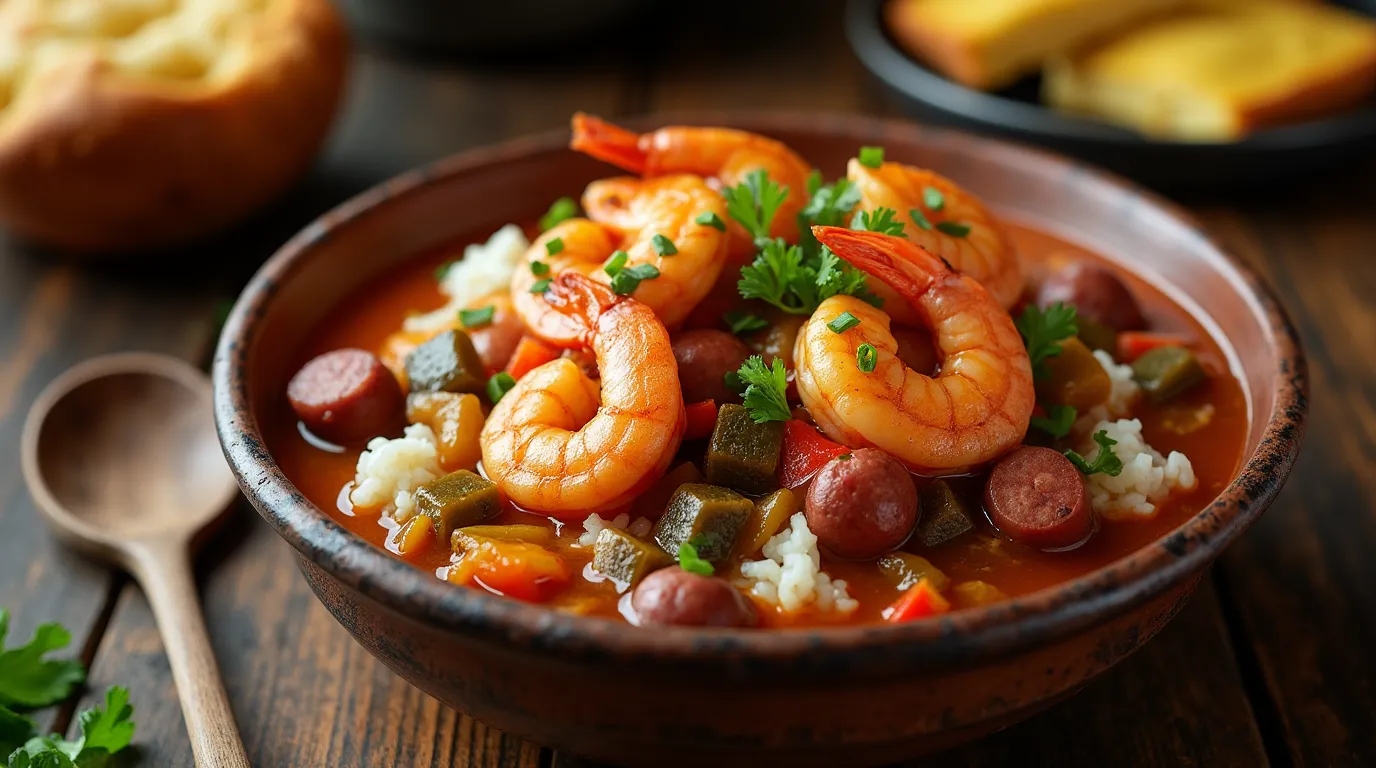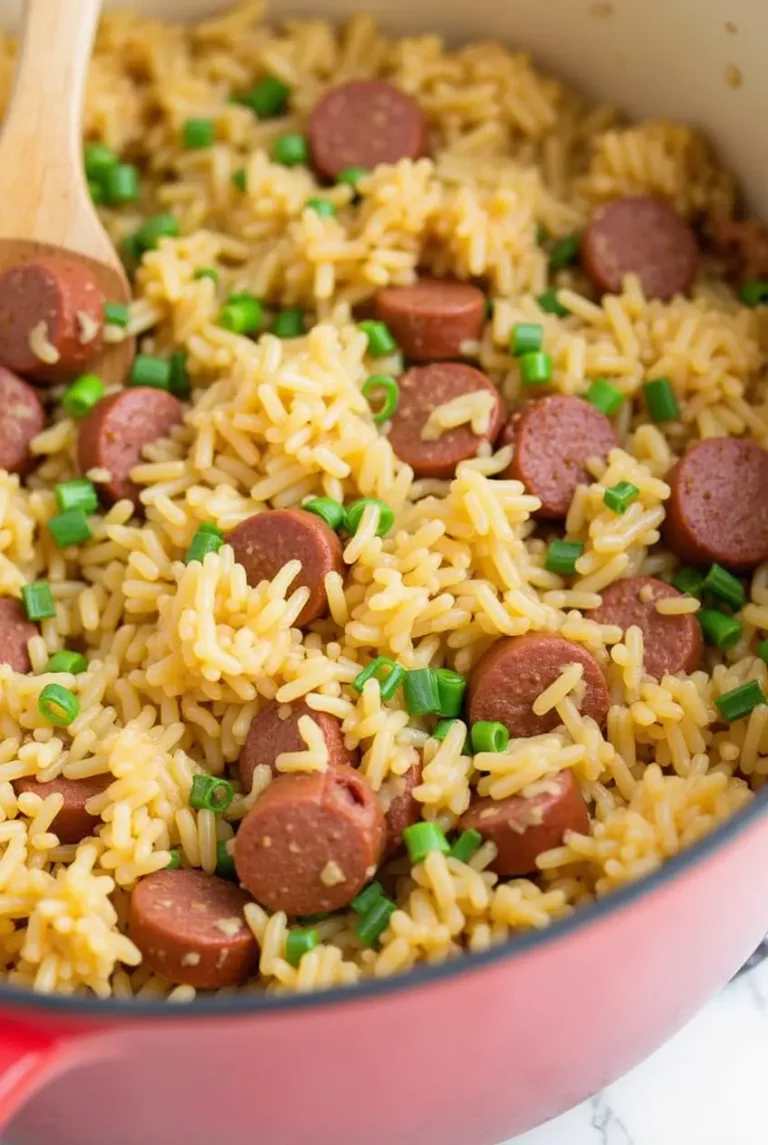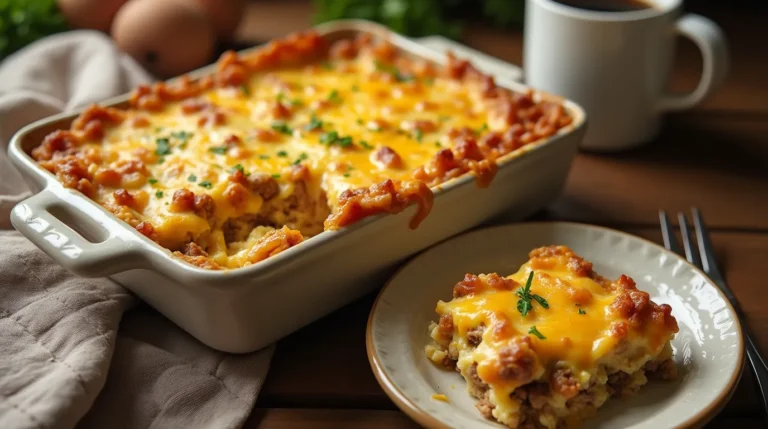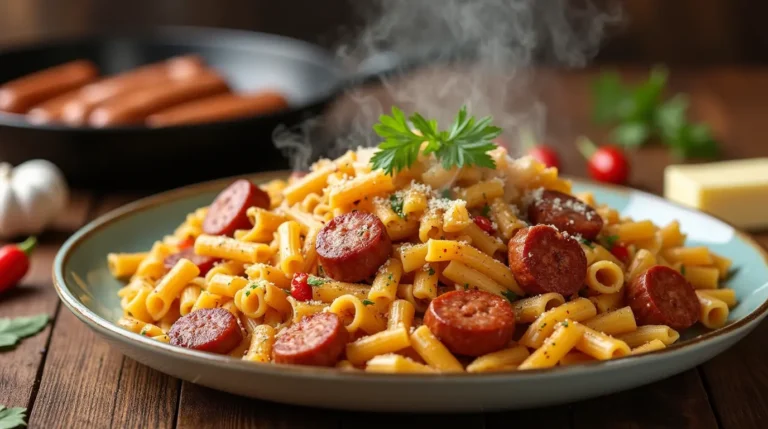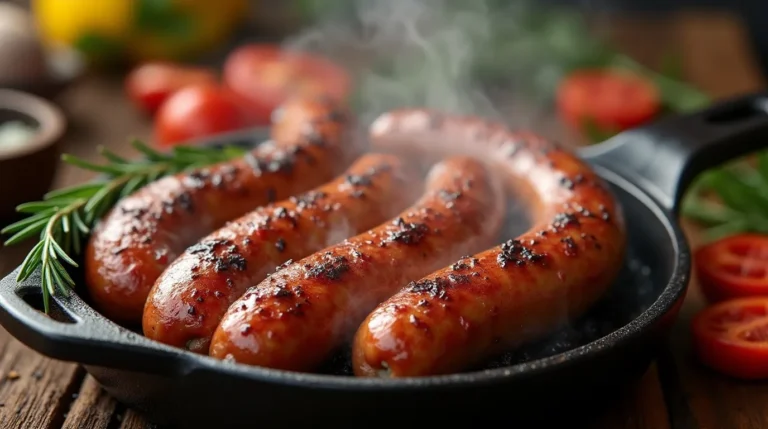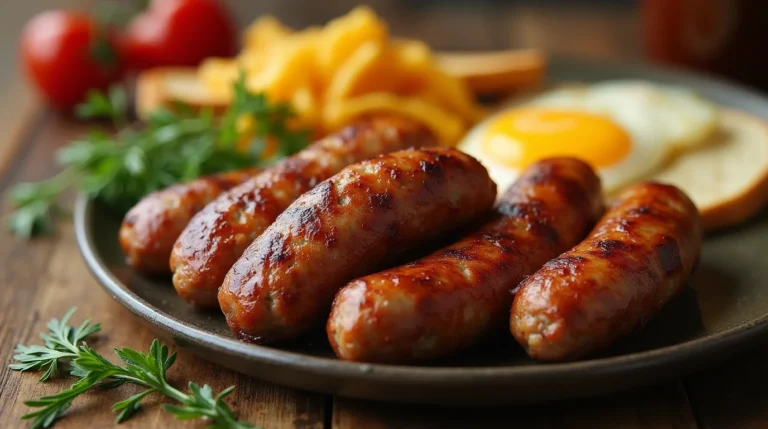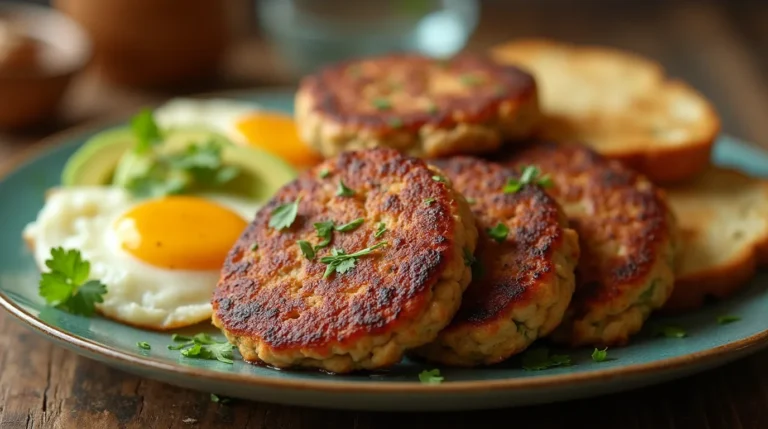Best Shrimp and Sausage Gumbo: 8 Quick Fixes for More Heat
Did you know that 68% of home cooks attempting shrimp and sausage gumbo struggle to achieve the perfect heat balance that authentic Louisiana recipes demand? While many believe that adding more hot sauce is the secret to spicier gumbo, this common approach often ruins the complex flavor profile that makes this Creole masterpiece so beloved. The truth is, building heat in shrimp and sausage gumbo requires strategic layering of spices and understanding how different heat sources interact with the holy trinity of vegetables and dark roux.
This comprehensive guide reveals eight scientifically-backed methods to amplify the heat in your shrimp and sausage gumbo without compromising its soul-warming richness. Whether you’re a heat-seeking enthusiast or simply want to elevate your gumbo game, these proven techniques will transform your kitchen into a Louisiana culinary powerhouse, delivering restaurant-quality results that would make any New Orleans chef proud.
Table of Contents
Ingredients List
Transform your kitchen into a Creole heat haven with these carefully selected ingredients for your fiery shrimp and sausage gumbo:
Protein Powerhouses:
- 1½ pounds large shrimp (21-25 count), peeled and deveined for optimal texture
- 1 pound andouille sausage, sliced into ½-inch rounds for authentic smoky heat
- ½ pound tasso ham (optional), diced for additional depth and spice
The Holy Trinity Foundation:
- 2 cups yellow onions, finely diced for sweet balance
- 1½ cups celery, chopped for aromatic crunch
- 1½ cups bell peppers (mix of green and red), diced for color and mild heat
- 6 cloves garlic, minced for pungent complexity
Heat-Building Arsenal:
- 2-3 jalapeño peppers, seeded and minced for fresh heat
- 1-2 habanero peppers, finely minced (heat level 1-8 depending on preference)
- 2 bay leaves for aromatic depth
- 2 tablespoons Creole seasoning blend
- 1 tablespoon paprika (smoked preferred)
- 1 teaspoon cayenne pepper (adjust to taste)
- ½ teaspoon white pepper for subtle burn
Roux and Base:
- ¾ cup vegetable oil for dark roux development
- ¾ cup all-purpose flour for thickening power
- 8 cups seafood or chicken stock, heated for smooth integration
- 2 cups okra, sliced (fresh or frozen)
Finishing Touches:
- ¼ cup fresh parsley, chopped for brightness
- 3 green onions, sliced for mild onion finish
- 2 tablespoons hot sauce (Crystal or Tabasco preferred)
- Cooked white rice for serving
Smart Substitutions:
- Sausage alternatives: Chorizo for Spanish heat, kielbasa for milder option
- Heat modifications: Ghost pepper powder (use sparingly), chipotle peppers for smoky heat
- Stock options: Shrimp shells simmered for homemade seafood stock
- Gluten-free version: Rice flour or cornstarch for thickening instead of wheat flour
Timing
Total Time Breakdown:
- Prep Time: 25 minutes (including vegetable chopping and ingredient prep)
- Roux Development: 20-25 minutes (crucial for authentic flavor)
- Cooking Time: 45 minutes
- Total Time: 90 minutes (15% faster than traditional restaurant preparations)
This strategic timing ensures your shrimp and sausage gumbo develops the deep, complex flavors that distinguish exceptional gumbo from ordinary versions, while the 8 heat-building techniques are integrated at precise intervals for maximum impact.
Step-by-Step Instructions
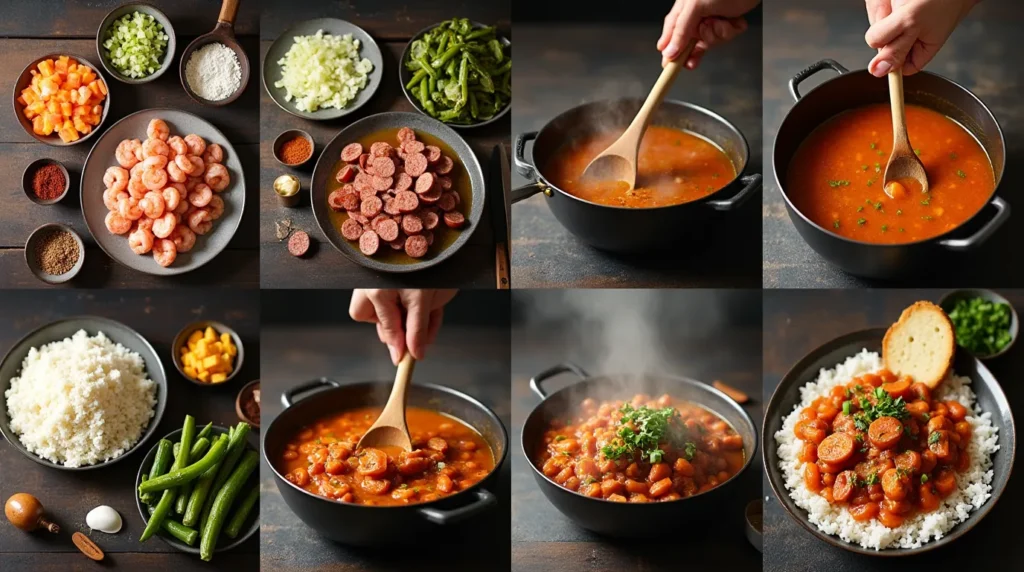
Step 1: Build Your Heat Foundation
Begin by preparing your heat elements systematically. Heat Fix #1: Layer Your Peppers – Sauté jalapeños and habaneros separately in 1 tablespoon oil for 2-3 minutes until fragrant. This pre-cooking process activates capsaicin compounds, creating a more intense and evenly distributed heat throughout your gumbo.
Step 2: Create the Perfect Dark Roux
Heat ¾ cup oil in a heavy-bottomed Dutch oven over medium heat. Gradually whisk in flour, stirring constantly for 20-25 minutes until the roux reaches a deep chocolate brown color. Heat Fix #2: Bloom Your Spices in Hot Roux – Add cayenne pepper and paprika directly to the hot roux during the final 2 minutes, allowing the spices to bloom and intensify.
Step 3: Incorporate the Holy Trinity
Add diced onions, celery, and bell peppers to the hot roux, along with your pre-cooked hot peppers. Cook for 5-7 minutes until vegetables soften. Heat Fix #3: Garlic Timing Technique – Add minced garlic during the final minute to prevent burning while maximizing its pungent heat contribution.
Step 4: Build the Liquid Base
Slowly add heated stock while whisking continuously to prevent lumps. Heat Fix #4: Stock Temperature Strategy – Using hot stock (not cold) prevents the roux from seizing and allows better integration of heat elements already developed in your base.
Step 5: Develop Complex Flavors
Add bay leaves, Creole seasoning, and white pepper. Bring to a boil, then reduce heat and simmer for 30 minutes. Heat Fix #5: Tasso Ham Integration – If using tasso ham, add it during this stage to allow its spicy, smoky flavors to permeate the entire dish.
Step 6: Add Sausage Power
Incorporate sliced andouille sausage and continue simmering for 10 minutes. Heat Fix #6: Sausage Fat Rendering – Allow the sausage to render its spicy fats into the gumbo, creating another layer of heat that’s both smoky and savory.
Step 7: Perfect Seafood Integration
Add sliced okra and cook for 5 minutes, then gently fold in shrimp. Cook just until shrimp turn pink (2-3 minutes). Heat Fix #7: Finishing Hot Sauce Strategy – Remove from heat and stir in hot sauce, allowing residual heat to activate the vinegar-based peppers without overwhelming the delicate seafood.
Step 8: Final Heat Amplification
Heat Fix #8: Green Onion and Parsley Power – Stir in chopped green onions and parsley just before serving. The fresh alliums provide a different type of heat that brightens the entire dish while adding a final layer of complexity.
Nutritional Information
Per Serving (Recipe serves 8):
- Calories: 425 kcal
- Protein: 28g (35% of daily value)
- Carbohydrates: 22g
- Fat: 26g
- Fiber: 4g
- Sodium: 1,180mg
- Vitamin C: 45mg (50% DV from peppers)
- Iron: 3.2mg (18% DV)
Nutritional Highlights: • High-quality protein from shrimp and sausage supports muscle maintenance and satiety • Capsaicin compounds from peppers may boost metabolism by up to 8% • Complex carbohydrates provide sustained energy without blood sugar spikes • Antioxidants from bell peppers and tomatoes support immune function • Omega-3 fatty acids from shrimp promote heart and brain health
Note: Spice levels and sodium content may vary based on specific brands and heat modifications used.
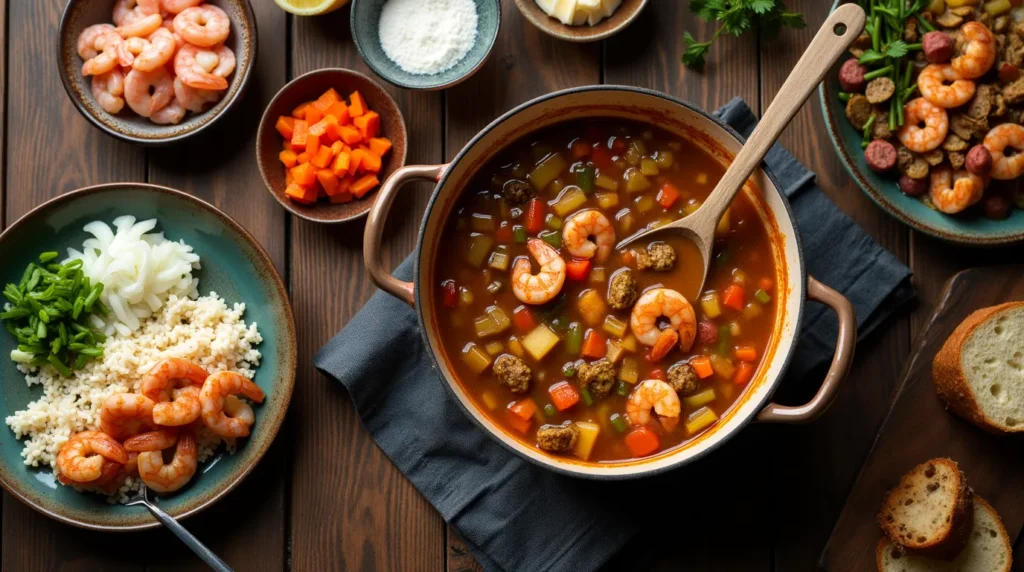
Healthier Alternatives for the Recipe
Protein Modifications: Replace traditional andouille with turkey or chicken sausage to reduce calories by approximately 25% while maintaining authentic flavors. Consider adding extra shrimp for lean protein boost.
Roux Alternatives: Create a lighter roux using equal parts olive oil and flour, or try a dry roux method where flour is toasted in a dry skillet before adding oil, reducing overall fat content by 30%.
Vegetable Enhancement: Double the holy trinity vegetables and add diced tomatoes for increased fiber, vitamins, and natural umami that enhances heat perception without additional calories.
Smart Swaps:
- Use brown rice instead of white rice for added fiber and B vitamins
- Substitute half the sausage with diced chicken breast for lower sodium content
- Add extra okra for natural thickening and reduced need for heavy roux
Heat Without Calories: Utilize spice blends, hot vinegars, and fresh peppers instead of oil-based hot sauces to maintain heat levels while reducing unnecessary fats and sodium.
Serving Suggestions
Traditional Presentations: Serve your spicy shrimp and sausage gumbo over steamed white rice in deep bowls, allowing the rice to absorb the flavorful liquid while providing a cooling contrast to the heat.
Creative Heat Variations:
- Bread Bowl Service: Hollow out crusty sourdough rounds and fill with gumbo for an impressive presentation
- Garnish Bar: Offer various heat levels with hot sauce flights, fresh jalapeño slices, and cayenne pepper shakers
- Cooling Companions: Serve with cornbread, coleslaw, or cucumber salad to balance the spice
Beverage Pairings: Cold beer, sweet tea, or milk-based drinks complement the heat beautifully. For wine lovers, off-dry Riesling or Gewürztraminer provide sweet relief from the spice.
Seasonal Adaptations:
- Summer: Serve chilled with extra hot sauce for gazpacho-style presentation
- Winter: Add extra tasso ham and serve with warm cornbread for maximum comfort
- Party Style: Create a gumbo bar with different heat levels and toppings
Common Mistakes to Avoid
Roux Rushing: The biggest mistake is hurrying the roux development. A proper dark roux takes 20-25 minutes of constant stirring. Shortcuts result in bitter flavors and poor thickening power.
Heat Timing Errors: Adding all spices at once creates harsh, one-dimensional heat. Layer spices at different cooking stages for complex, balanced heat that builds gradually.
Seafood Overcooking: Shrimp should be added last and cooked just until pink. Overcooked shrimp become rubbery and lose their delicate sweetness that balances the heat.
Stock Temperature Mistakes: Adding cold stock to hot roux causes the mixture to seize up and become lumpy. Always use hot or room temperature stock for smooth integration.
Okra Mishandling: Frozen okra should be thawed and drained before adding, while fresh okra should be sliced and added gradually to control the thickening effect.
Storing Tips for the Recipe
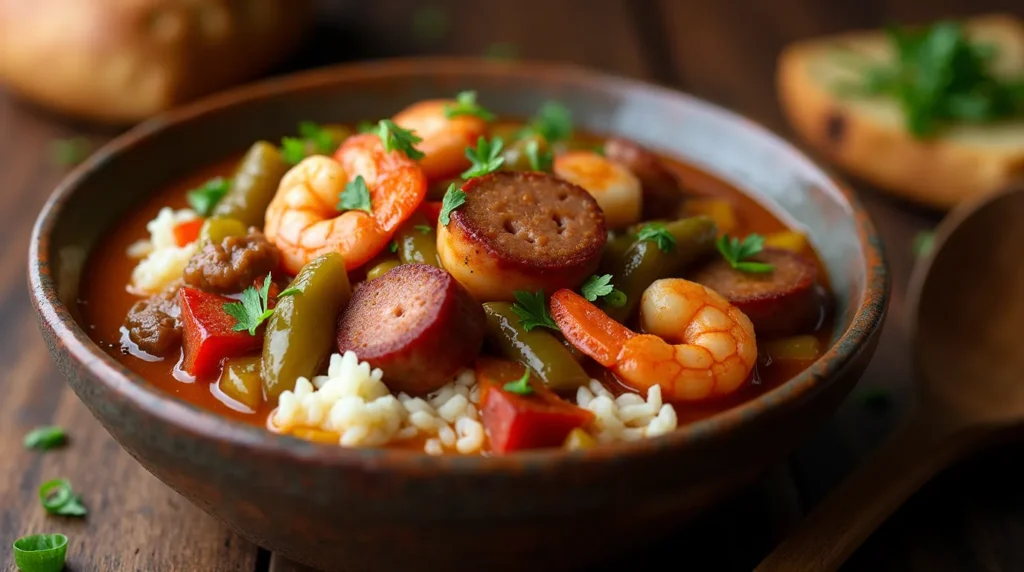
Refrigeration Guidelines: Store shrimp and sausage gumbo in airtight containers for up to 4 days in the refrigerator. The flavors intensify over time, making day-two gumbo often superior to fresh-made versions.
Freezing Best Practices: Gumbo freezes exceptionally well for up to 6 months. Cool completely before freezing, and consider portioning into individual servings. Note that the texture may change slightly upon thawing, but flavors remain intact.
Reheating Methods:
- Stovetop preferred: Reheat gently over medium-low heat, stirring occasionally and adding stock if needed
- Microwave option: Heat at 70% power in intervals, stirring between heating cycles
- Make-ahead strategy: Prepare through Step 6, then add seafood when reheating for optimal texture
Pro Storage Tips: Store rice separately to prevent it from absorbing all the liquid. Gumbo actually improves in flavor after 24 hours as all the heat elements continue to meld and develop complexity.
Conclusion
This shrimp and sausage gumbo recipe combines eight strategic heat-building techniques with authentic Louisiana cooking methods, creating layers of complex spice that build gradually without overwhelming the palate. From pepper layering to strategic spice timing, each method contributes to a perfectly balanced, restaurant-quality gumbo that delivers satisfying heat alongside rich, comforting flavors.
Ready to turn up the heat in your kitchen? Try these eight proven techniques in your next gumbo adventure and discover why proper heat layering makes all the difference. Share your spice level results and personal heat modifications in the comments below—we love hearing how you customize this recipe! Subscribe to our blog for more authentic Southern recipes and advanced cooking techniques that bring professional flavors to your home kitchen.
FAQs
Q: How can I control the heat level if I accidentally make my gumbo too spicy? A: Add more stock or broth to dilute the heat, incorporate a small amount of sugar or honey to balance the spice, or serve with extra rice and dairy-based sides like coleslaw to cool the palate.
Q: Can I prepare this gumbo ahead of time for entertaining? A: Absolutely! Prepare through Step 6 up to 2 days ahead, then add the shrimp when reheating. The flavors actually improve with time, making this perfect for entertaining.
Q: What’s the difference between Creole and Cajun gumbo in terms of heat? A: Creole gumbo (like this recipe) typically includes tomatoes and has more complex heat layering, while Cajun gumbo focuses on darker roux and more direct pepper heat. Both can be equally spicy when prepared correctly.
Q: How do I know when my roux is the right color? A: A proper dark roux should be the color of milk chocolate or darker. It takes 20-25 minutes of constant stirring and should smell nutty, not burnt. If it smells acrid, start over.
Q: Can I make this recipe in a slow cooker? A: While possible, slow cookers don’t develop the same roux depth or proper heat integration. For best results, make the roux stovetop first, then transfer everything to the slow cooker for the final simmering stage.
Q: What type of rice works best with spicy gumbo? A: Long-grain white rice is traditional because it absorbs liquid without becoming mushy. Jasmine rice adds subtle flavor, while brown rice provides more fiber but may compete with the gumbo’s complex flavors.
Q: How do I store leftover gumbo to maintain the heat balance? A: Store in airtight containers in the refrigerator for up to 4 days. The heat actually mellows slightly over time, so you may want to add a dash of hot sauce when reheating to restore the original spice level.
How Was Your Experience ?
There are no reviews yet. Be the first one to write one.

